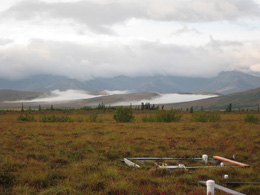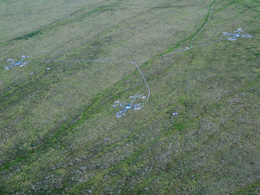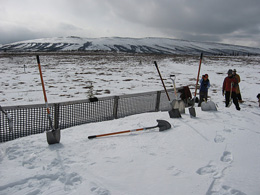The Carbon in Permafrost Experimental Heating Project (CiPEHR)
The Carbon in Permafrost Experimental Heating Research (CiPEHR) project is an ecosystem warming experiment that was established in 2008 to test hypotheses about changes in the carbon cycle that are expected as a result of warming temperatures and permafrost thaw. The CiPEHR project uses snow fences coupled with spring snow removal to increase soil and permafrost temperatures and open-top chambers to increase growing season air temperatures.
The soil warming treatment, hereafter called winter warming, was achieved using six replicate snow fences (1.5 m tall × 8 m long) that trap insulating layers of snow. Each winter warming treatment and winter warming control area contains two summer warming plots and two summer warming control plots. Summer warming is achieved using 0.36 m2 × 0.5 m tall open-top chambers, which are set out during the snow-free period, between the first week in May and the last week of September.
Core measurements at CiPEHR include continuous monitoring of soil temperature and moisture, thaw depth, water table depth, and carbon dioxide fluxes. We also measure plant productivity and phenology, soil and plant nutrient status, methane fluxes, and stable and radioactive carbon isotopes in plants and soils.
 |
 |
 |
|
Fall colors at CiPEHR (photo by S. Natali) |
aerial view of CiPEHR (photo by S. Natali) |
Snow shoveling in spring (photo by S. Natali) |
back to research













